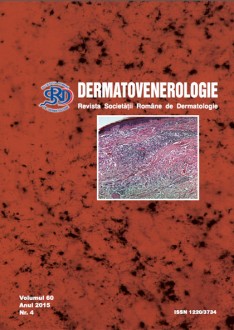TIBOLA (tick-borne lymphadenopathy) is a rickettsiosis transmitted to humans through a tick of the Dermacentor genus, most commonly incriminated pathogen being Rickettsia slovaca.
A 55-year-old female patient was consulted for an inflammatory red purple plaque, infiltrated, round with a diameter of 2 cm, located in the upper part of the scalp and emerged after 45 days, about 10 days after a tick bite occurred in February 2015, during a walk in a forest. The sting was initially accompanied by an itchy edematous erythema of the cephalic region. The inflammatory plaque was accompanied by painful right laterocervical lymphadenopathy. The patient did not have fever or impaired general condition. Common blood and biochemical laboratory investigations were normal. Antibody testing for Borrelia burgdorferi was negative. She was treated with doxycycline 200 mg/day for 3 weeks with the disappearance of the inflammatory lesion and the laterocervical lymphadenopathy and the persistence of a residual alopecic area. TIBOLA diagnosis was established based on clinical, anamnestic criteria and improvement under treatment with doxycycline.
The epidemiological characteristics of TIBOLA are: seasonal distribution in the cold months of the year (September to May) and geographical location in the Mediterranean and Eastern Europe. The average incubation is 7 days. Clinical diagnosis of TIBOLA is based on the following binding specific criteria: the bite of a large tick on the upper body (90% on the hairy skin of the head), necrotic eschar at the site of the tick bite surrounded by fixed erythematous halo and painful regional lymphadenopathy (occipital , cervical) and nonspecific minor criteria: headache, fever, arthromyalgia, asthenia, rash. A certainty diagnosis is based on microbiological examinations of which indirect immunofluorescence is the most widely used. The evolution of the disease is rapidly improving under treatment with the disappearance of the fever in a few days and the lymphadenopathy in a week with a persistent cicatricial alopecia on the eschar. The treatment of choice is doxycycline for adults and new-generation macrolides (azithromycin and clarithromycin) in children and pregnant women.
TIBOLA is a rickettsiosis with a growing emergence in Romania, in part because of the spread of ticks of the genus
Dermacentor.


